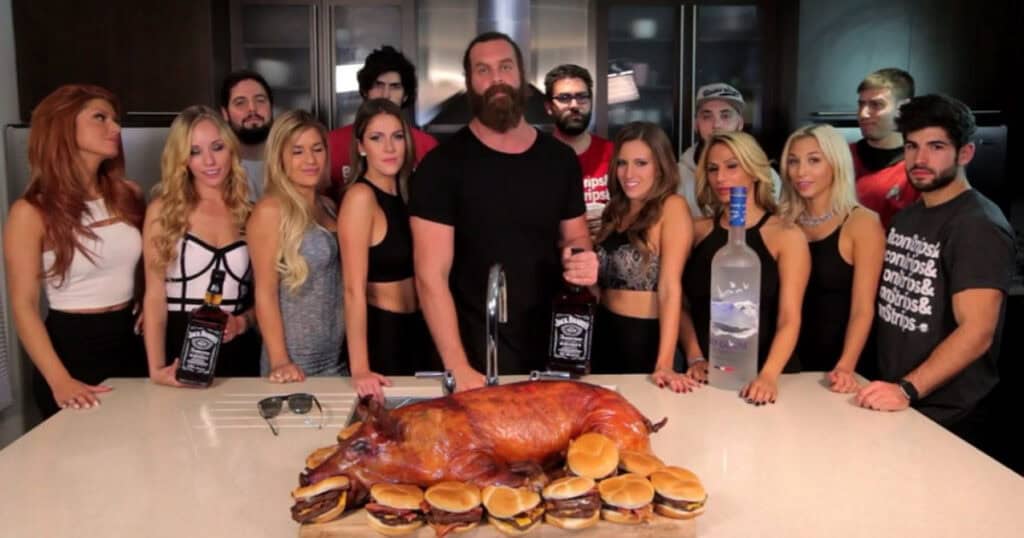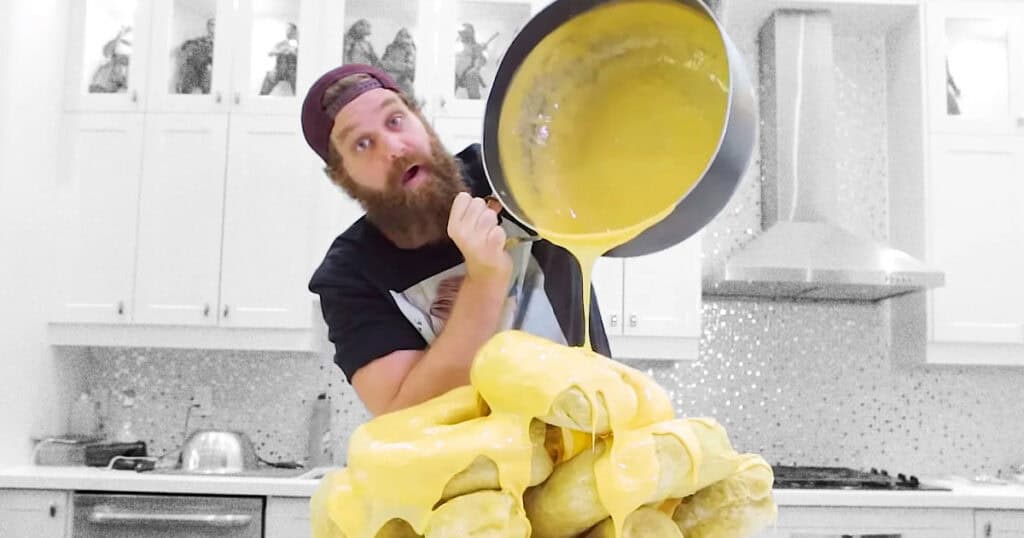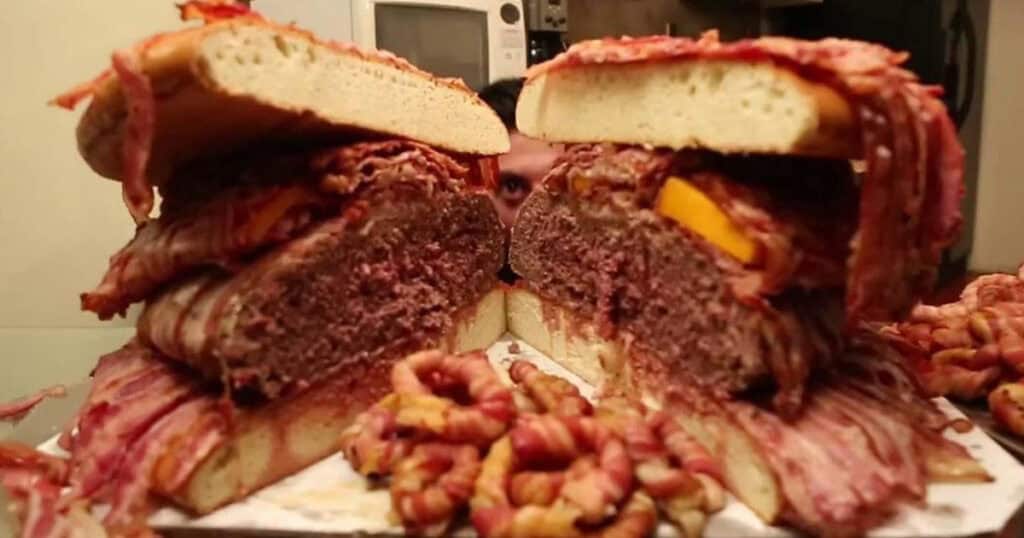
The YouTube channel Epic Meal Time was an unlikely viral phenomenon that took the internet by storm in the early 2010s. Its brilliant yet deceptively simple premise of creating outrageously unhealthy fast food concoctions resonated immensely with a certain subset of viewers. Episodes like the staggeringly caloric “Fast Food Lasagna” and “Turbacon Epic Thanksgiving” special would build anticipation by meticulously assembling and teasing the final caloric monstrosity, while also tapping into ephemeral cultural trends of the time like the obsession with bacon and the exaggerated macho bro persona embodied by host Harley Morenstein.
This novel format combined shocking excess, culinary debauchery, frat boy humor, and a liberal dose of alcohol into a perfect storm of viral wildfire, generating massive word-of-mouth buzz that rapidly propelled Epic Meal Time from a low-budget cooking channel to one of the biggest presences on the entire YouTube platform within its first few years. At its peak, the show’s audacious videos were practically unavoidable in the cultural conversation.
The origins of this improbable phenomenon can be traced back to a viral stunt video of an unassuming Morenstein devouring a gargantuan Wendy’s hamburger containing six beef patties and eighteen strips of bacon, all set to the iconic theme from The Terminator. This sophomoric display struck an unexpected chord with online audiences, racking up thousands of views. Recognizing the strong interest in this outrageous stunt eating video, Morenstein and his friend Alex Perrault decided to launch a full cooking program centered around creating increasingly grotesque fast food Franken-creations that pushed the boundaries of gluttony and good taste.
The pair filmed the first official Epic Meal Time episode in July 2010, titled “The Worst Pizza Ever!” It featured the duo assembling a 5,200-calorie monster pizza by purchasing random items from various major fast food chains – KFC popcorn chicken, a Taco Bell Crunchwrap Supreme, McDonald’s Big Mac and Chicken McNuggets, Wendy’s Baconator and fries, A&W burger and onion rings – and stacking it all on a plain cheese pizza before melting it into an ungodly culinary Eldritch horror. Despite its intentionally cheap and amateurish production values, the novel shock value and guilty pleasure entertainment factor of this “frat bro food porn” concept quickly gained Epic Meal Time a cult following of viewers eager to see just how far they could push the boundaries of gluttony in subsequent episodes.
Part of the show’s early viral appeal stemmed from its overall aesthetic and eccentric cast of characters. Morenstein describes the show as “Jackass in the kitchen.” The logo of Epic Meal Time is inspired by the American stunt and prank show, featuring a skull with an upside-down cooking pot on top, and crossed carving knives replacing the crutches. As the host, Morenstein fully embodied and leaned into an overly macho, borderline sleazy on-camera persona, frequently peppering his speech with aggressive frat bro lingo like “bro,” “dude,” and bizarrely sexual references to the food items. His sidekick and childhood friend Perrault adopted the silent tough guy role of the fan-favorite character “Muscles Glasses,” maintaining an intimidating scowl while wearing a different bacon-printed shirt in each episode as a tongue-in-cheek costumed gimmick.
Morenstein and crew shamelessly incorporated alcohol and obsessive amounts of bacon into nearly every unholy culinary creation as part of the show’s masculine id-fueled vibe glorifying wild overindulgence. Episodes would frequently show them casually pounding cans of beer or sloppily pouring liquor directly onto the grotesque food amalgamations. The unique viewing format of meticulously assembling each outrageous meal over the course of the video and slowly teasing the final calorie-laden, gag-inducing product reveal also compelled viewers to dutifully watch each episode until the very end climactic “food porn” money shot.

As word-of-mouth promotion and mainstream media coverage exponentially grew, Epic Meal Time achieved a dizzying series of viral milestones in its first few years on YouTube. It became the fastest channel to hit 1 million subscribers, earned lucrative sponsorship deals and random celebrity guest collaborations with the likes of skateboarding legend Tony Hawk and actor Arnold Schwarzenegger, harkening back to the initial viral video featuring the Terminator theme, and even managed to spin off a short-lived television show on RevisionThree called Epic Chef pitting contestants against each other in a cooking competition to create the most caloric-bombs.
A Reddit AMA from 2012 is revealing of Harley Morenstein’s personality, motivations, and adventures. In this candid Q&A session, Harley shared insights into his thoughts, experiences, and the making of Epic Meal Time. He revealed the cost of the infamous “Turbaconepicentipede” dish, stating, “It cost about 5000$ to stuff 10 pigs with 50 birds and attach them all ass to mouth and garnish them with Baconators.” When asked about the inspiration behind the channel, he humorously replied, “Hashish.” Meanwhile, when questioned about how he managed to keep the weight off despite indulging in excessive culinary creations, he quipped, “Copious sexual activity.” He also discussed the show’s success, attributing it to the fact that “people are looking for ridiculous, over the top, and entertaining content.” Additionally, he shared his unapologetic approach to cooking, stating, “I don’t consider myself a chef, I consider myself a cook. I like to make food that’s fun, and that people will talk about.” This AMA offers a unique perspective on Harley’s personality, creative vision, and the Epic Meal Time phenomenon, providing a fascinating glimpse into the mind behind the viral sensation.
Seeking to extend their 15 minutes of fame as a novelty internet phenomenon before the inevitable backlash, Epic Meal Time’s founders rushed to expand into other entertainment verticals and cash recruitable revenue streams. They launched an Epic Meal Time branded merchandise line including a published cookbook, mobile game, and even action figure line that allowed fans to construct their own fantasy acid trip culinary abominations at home. Merchandise sales were strong in the early years as the channel’s popularity remained white hot among its passionate fanbase across social media platforms.

However, the core creative team’s runaway success also bred internal conflicts, distrust, and corporate power struggles behind the scenes that would slowly tear the group apart. In 2011, co-creator Sterling Toth sued Morenstein and his brother Darren alleging he was improperly pushed out of the company, claiming the former’s greed and naked lust for power over others destroyed their once close personal friendship. The lawsuit was eventually settled out of court for an undisclosed sum.
Two years later in 2013, two of Epic Meal Time’s most popular on-camera personalities – Alex Perrault’s fan-favorite silent hulking character “Muscles Glasses” and crew member Tyler Lemko – both acrimoniously departed the show. They claimed a growing disconnect with Morenstein and his increasing corporate management priorities, stating they were not being treated or financially compensated fairly commensurate to the value they brought to the productions as they morphed from a fun passion project among friends into a more professional and businesslike operation.
“I felt like I wasn’t being treated fairly considering the value I brought to the show,” Perrault bluntly stated in an interview with entertainment publication New Rockstars. “Other than Harley, no other member of the crew had any ownership of the company. There were many promises made over the years that were not kept. It got to the point where I couldn’t trust Harley as a friend and Harley and his brother as business associates.” Lemko echoed similar sentiments, saying “Business just got in the way of it being fun.”
As cultural phenomena and meme obsessions like the bacon craze inevitably faded with time, Epic Meal Time’s central shock value gimmick of excessive gluttony began wearing thin with viewers who had grown accustomed to the premise. The show’s very concept – taking relatively simple fast food staples and extrapolating them into grotesque, unwatchable extremes via obscene caloric excess – offered little to no room for sustained novelty or substantive evolution of its format over years of weekly videos.
Viewership plummeted from viral heights of tens of millions of views in the channel’s first few years down to the low single-digit millions by the mid-2010s as competitors unapologetically copied their successful formula. By the early 2020s, new uploads were viewed by merely tens of thousands of people as younger generations of viewers on YouTube gravitated towards other viral stars and emerging genres more in step with the rapidly shifting cultural zeitgeist of social media entertainment.

In a rare candid interview, Morenstein acknowledged that the repetitive and inherently limited nature of Epic Meal Time’s shock value calorie porn premise hamstrung its longevity as the YouTube algorithm shifted to favor more frequent, longer content from prolific creators. “We initially created 2, 3-minute videos… we couldn’t keep up with these mega [corporate] companies that were literally banging out 50 food videos a week, some of which were ideas that we’d already done before but they were getting 10x more views as they had insight into the algorithm,” he explained.
Morenstein and his pared-down crew attempted to shake up the premise by introducing twists like taking on entire fast food menu challenges, but these pivots could not fully revive the exponentially fading novelty factor and Epic Meal Time’s overwhelming lack of long-term sustainable content evolution. As the channel’s 10th anniversary loomed in 2019, Morenstein strongly considered finally putting a fork in the show’s run for good before ultimately deciding to continue creating scaled-back content, though at a significantly reduced pace and frequency compared to its viral peak.
In retrospect, the bizarre cultural phenomenon of Epic Meal Time exemplified both the incredible potential of creative digital content to turn shocking, sophomoric stunts into viral media sensations, but also the immense challenges of sustaining that fleeting interest and relevance over years as cultures, trends, and public tastes rapidly evolve in the online world.
What began as a simple novelty video of a few friends captivatingly indulging their most juvenile, gluttonous food fantasies on camera for laughs exploded into an international brand, inspiring countless imitators in the burgeoning “food porn” space on YouTube before inevitably burning out its ultra-niche shock value premise and fading into relic status as a nostalgic relic of the platform’s adolescent years.
At its peak thunder, Epic Meal Time’s audacious calorie-bomb videos were inescapable in the cultural conversation andosphere of internet memes and viral media. The show’s unique application of stunts, raunch, and culinary excess tapped into something primal in the YouTube audience’s id, generating the kind of awestruck rubbernecking and visceral dude-bro “Did you see that?!” appeal that was a crucial ingredient in becoming a bona fide phenomenon in those early days of the entertainment democratization.
However, Epic Meal Time’s very conceit as an exercise in gluttony for gluttony’s sake was also the limitation that made long-term sustainability and evolution extremely difficult. There was simply a finite well of shock value to derive from the same basic premise of piling increasingly obscene amounts of fast food items into Franken-food-Monsters week after week, year after year. The team could pivot to different recurring segment ideas like taking on entire fast food menu challenges in an attempt to prolong interest, but at their core, these were mere remixes of the central gimmick rather than true substantive evolutions of the format itself.
As the hype cycle cooled and the novelty faded, Epic Meal Time’s team would descend into the same kind of acrimonious behind-the-scenes clashes and corporate power struggles that derailed many overnight viral media successes throughout the decades. The increased pressures of trying to monetize that initial lightning in-a-bottle through merchandising while simultaneously sustaining viewership and engagement metrics threw a wrench into what had originated as a labor of love creative project among friends just wanting to indulge their wild sides for laughs. The increasingly professional and business-oriented mindset created skepticism and resentment within Epic Meal Time’s roster of creatives who felt sidelined, under-compensated, and creatively stifled.
In the end, Epic Meal Time burned bright and feverishly for a mercurial few years at the heights of its runaway virality. But the channel’s inability to substantively evolve the format beyond its central caloric-excess gimmick combined with internal conflicts sowed the seeds for its decline just as swiftly as it had ascended. While no longer the ubiquitous pop culture force it once was, Epic Meal Time endures as a nostalgic symbol representing the unrestrained hedonism, anti-cultural attitudes, and puerile gimmickry that captivated a vital chunk of the internet’s attention in YouTube’s adolescent phase.
For many viewers who came of age in that era, watching Epic Meal Time’s latest culinary obscenities was akin to a digital rite of passage steeped in shock value and guilty indulgences. The channel exemplified how the democratization of creativity on new platforms could elevate seemingly ludicrous stunts and simplistic premises into landmark cultural phenomena, if even for a fleeting moment in internet time. While perhaps a relic now, Epic Meal Time’s legacy lives on as an emblem reminding us of both the unparalleled potential and limitations of virality in the digital age.
The post What Happened to Epic Meal Time? appeared first on JoBlo.
Leave a Reply